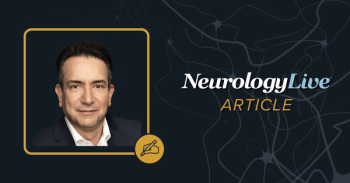
The Recent Revolution in Acute Stroke Care
The co-director of the UPMC’s Center for Endovascular Therapy spoke about the gains that stroke care has made in the last few years.
Tudor Jovin, MD
Acute stroke care has undergone massive changes in the past few years, mostly thanks to confirmatory data regarding the success of thrombectomy in patients with large vessel occlusion.
For Tudor Jovin, MD, the most important facet of that improved care has been the assessment of the treatment windows for these patients. He noted that this new understanding has led to guideline adjustments and has had a real impact on the treatment of patients who experience an acute stroke.
To provide further insight, the assistant professor of neurology and neurosurgery at the University of Pittsburgh School of Medicine, co-director of the Center for Endovascular Therapy at the University of Pittsburgh Medical Center spoke with NeurologyLive about the state of acute stroke care.
NeurologyLive: What’s been the state of acute stroke care in recent years?
Tudor Jovin, MD: Acute stroke therapy has undergone a revolution the last 2 years because there are now very good data proving that there is significant benefit from thrombectomy in patients with large vessel occlusion whether or not they are receiving tissue plasminogen activator (tPA). Until 2015, the only available treatment for acute stroke has been intravenous tPA, and it works and is a great treatment, but usually patients with large vessel occlusion don’t respond that well to tPA. The tPA is still better than no treatment, but there was a lot of room for improving outcomes in these conditions. So, in 2015, there were 5 trials published in the New England Journal of Medicine. They largely enrolled patients in the 0- to 6-hour time window and showed an overwhelming benefit of thrombectomy, whether patients received intravenous tPA because they were eligible for it before or not. In 2016, there was another trial that basically showed the same thing, and there’s been individual-level meta-analyses that have shown the staggering number needed to treat those—2.5 would get somebody from a higher level of disability to lower level disability with this treatment. That’s one of the most powerful treatments that we have in medicine, in general. Certainly, with procedural-based treatments, there’s hardly any treatments that are so effective as embolectomy for stroke.
There are still some questions that remain to be answered with this approach, especially with a late time window, or late presenting patients, because of most of the trials that I mentioned basically used the 0- to 6-hour time window. Even with those using later windows, most of the patients who were enrolled were in the 0- to 6-hour time window. There was not enough data in the beyond-6-hour time window to significantly conclude that there’s benefit, but we have, for a long time, suspected that for patients who still have salvageable brain, reperfusion is beneficial.
What’s been the biggest recent change in acute stroke?
At the end of 2017, early 2018, there was been a trial called DAWN that I had the privilege of being 1 of the 2 lead investigators of, and it showed the overwhelming benefits of thrombectomy in patients selected based on the presence of substantial mismatch, which was defined as a mismatch between the amount of dead brain and amount of territory at risk. That was assessed by means of a clinical objective. The infarct, prior to the procedure, was out of proportionally small to the clinical deficit, suggesting that patients still had substantial areas of salvageable brain. Thrombectomy in these patients compared to no treatment was shown to have an overwhelming benefit—the highest for a treatment of any kind that a stroke trial has shown to date in the 6- to 24-hour time window. These findings were confirmed by a very similar trial that was published a few months later, called DEFUSE-3, that used the 6- to 16-hour time window and enrolled patients also with evidence of mismatch. This time the mismatch was defined by imaging measuring the amount of dead brain just like in DAWN, but the amount of tissue at risk was assessed based on perfusion studies.
We now have evidence that has led to a change in guidelines to endorse treatment up to 24 hours with these select patients, with proximal large vessel occlusion. That has dramatically expanded the number of patients that could potentially be treated. It is estimated, with data from our center and other confirmatory data from other centers as well, that 30% to 50% of the patients with large vessel occlusion can be treated up to 24 hours. That basically expanded the time window for acute stroke interventions to 24 hours in select patients.
Outside of that patient population, what developments have occurred?
There are still obviously, we’re talking about patients with proximal large vessel occlusion where we have Level 1 evidence of benefit, and these patients make up maybe one-third of patients with acute stroke. The majority of acute stroke patients don’t have large vessel occlusion, and for them, the options are basically intravenous tPA, which is administered within 4.5 hours. There have been some trials trying to expand the time window for intravenous tPA or other related drugs, but these trials have not been successful, except for one that was not really trying to expand the time window but was trying to treat patients with unknown time of onset to infer the window based on MRI scans. That’s the WAKEUP trial. Patients with unknown time of onset, most of them wake up with strokes or awake with neurological deficit, so nobody knows when the symptoms started. Certain MRI signatures suggest that the stroke onset time was within the 4.5-hour time window, and this trial has shown benefit in patients who are selected based on this signature. Patients with wakeup stoke can be treated within 4.5 hours of when they’re actually witnessed with symptoms. If they have this signature on MRI, this randomized study showed benefits with intravenous tPA. I believe this needs to be confirmed by a confirmatory trial before this treatment is ready for being considered standard.
Another important development in acute stroke treatment has been thrombolysis. There have been some trials that have looked at the comparison between intravenous tPA and tenecteplase. While 1 study performed in Norway failed to show any benefit of tenecteplase over tPA, another study that looked at patients who received bridging intravenous therapy before they get embolectomy had shown that tenecteplase has a higher rate of vessel recanalization prior to thrombectomy when given intravenous tPA. It had a higher rate actually opening up large vessels—still relatively low, but higher than tPA. On the basis of this trial, many are now wondering whether tenecteplase should not replace intravenous tPA.
There are some other questions regarding the dose of tPA, more so in recent trials published within the last 2 years. They aimed to establish non-inferiority of lower dose tPA—0.6 mg/kg versus 0.9 mg/kg—as the standard dose, and just fell short of showing that.
Transcript edited for clarity.
Newsletter
Keep your finger on the pulse of neurology—subscribe to NeurologyLive for expert interviews, new data, and breakthrough treatment updates.



























